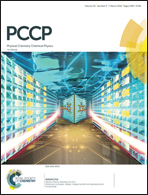Structural, electronic and adhesion characteristics of zinc/silica interfaces: ab initio study on zinc/β-cristobalite
Abstract
The weak interaction between zinc and silica is responsible for a poor performance of anti-corrosive galvanic zinc coatings on modern advanced high strength steels. With the goal of identifying its microscopic origin, we report an extensive ab initio study on the structural, electronic, and adhesion characteristics of a variety of model zinc/β-cristobalite interfaces, representative for different oxidation conditions. We show that the weakness of the zinc–silica interaction at non polar interfaces is driven by the presence of surface siloxane rings. These latter are drastically detrimental to interface adhesion when intact and their breaking is impeded by a large energy barrier. Conversely, the characteristics of polar interfaces are principally driven by the capacity of zinc to screen the surface compensating charges and to form O–Zn bonds. This screening is especially efficient in an oxygen-rich environment where the substrate-induced partial oxidation of the zinc deposit produces a considerable enhancement of interface adhesion. The identified microscopic mechanisms of interface interactions furnish precious guidelines towards practical attempts to improve adhesion. In particular, processes which enable breaking the surface siloxane rings are expected to noticeably reinforce the interaction at non-polar interfaces.



 Please wait while we load your content...
Please wait while we load your content...